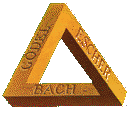In the discussion of complex systems with several logical levels of description may appear self-recursive circularities which, evolving over several levels, close in to the starting point.
Douglas Hofstadter was the first to study them in "Gödel, Escher, Bach: an eternal golden braid", 1980 Pulitzer prize winner, calling them "Strange Loops", and defined them in the cases of the development of formal logical Gödel theorems, of J.S. Bach musical scores, in particular "The Art of Fugue" and "The Musical Offering", and in M.C. Escher works.
|
«I realized that for me Gödel, Escher and Bach were only shadows cast in different directions by some central solid essence. I tried to reconstruct the central object and came out this book. »
|
"... Godel, Escher, Bach: a great logician, a great painter, a great musician. What binds these names, except the glory? A Strange Loop. And what a Strange Loop? Hofstadter suggests: "The phenomenon of "Strange Loop" is that of finding unexpected, going up or going down the steps of some hierarchical system, at the starting point." is a phenomenon that Escher has drawn , Bach has set to music, which Godel has placed at the heart of his theorems. ..." (D.H.)








































No comments:
Post a Comment
Note: Only a member of this blog may post a comment.